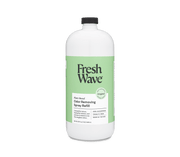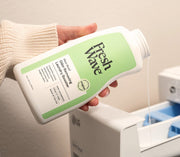There are those certain domestic tasks that can be surprisingly tricky: folding a fitted sheet, the right temperature to wash whites, how to properly clean curtains, and arguably the most frustrating, how to clean a duvet.
A duvet is a soft insert filled with either down, feathers, wool, or synthetic material to add volume and insulation to a duvet cover. Many duvets are washable, but there are a few things you should know before tackling the project on your own.
Read our helpful tips for cleaning a duvet at home and keep it fresh through the heat of summer, the cold of winter, and beyond.
Four Steps to Clean a Duvet at Home
- Check its material: down, feathers, wool, or down alternates
- Follow cleaning instructions based on materials
- Dry properly to avoid damage
- Use Fresh Wave to deodorize between washings
Check the Duvet's Material
Before you wash anything, whether it’s a pair of boots or a jacket, always check its material. When cleaning at home, this step is crucial to find out what cleaning products could damage your items.
General rules for how to clean a duvet call for removing it from its cover before placing it in the washing machine on a delicate cycle. But feathers, wool, and synthetic stuffing all require different water temperatures, unique handling in the washing machine and duration in the dryer. Once you know the specific care instructions for your duvet, you can remove it from the duvet cover and begin cleaning.
Washing a Feather or Down Duvet
Many people have a duvet filled with down or feathers. Down comes from the chest and underside of a bird and contains no quills. This makes it softer and able to hold its shape more effectively. Feathers come from the top of the bird, tend to be longer, and contain a portion or all of the quill.
For down duvets, specifically, the washing machine’s temperature should be warm, not hot, and your detergent should contain gentle or natural ingredients.
Before putting anything in the washing machine, allow water to fill up part of the way. For a King-size duvet, you may need to use the high-capacity, front-loading washers you find in a laundromat. Otherwise, when cleaning a duvet at home, we recommend:
- Treat this load of laundry as a medium to large load.
- Add 1-3 tablespoons of detergent to your machine
- Mix in a few capfuls of Fresh Wave Laundry Booster to address any stubborn, set-in odors
- Put in your duvet
- Wash on delicate with an extended rinse cycle
Adding odor eliminating products in the wash is a great way to keep garments, bedding, and everything in-between smelling fresh when detergent alone simply can’t. Find out more about our natural ingredients and the many ways you can use Fresh Wave Laundry Booster.
Washing a Wool Duvet
Unlike down or feathers, wool fibers contain a cuticle that gives them a natural form of water resistance. Many people use wool duvets in the winter because the fibers are also excellent at retaining heat and provide softness and comfort on the top layer of your sheets.
For wool in particular, the washing machine’s temperature should be cool, not warm. Many people also recommend adding wool balls or tennis balls to your washing machine because it keeps the material from clumping and retaining soap. When it comes to detergent, only wash a wool duvet with wool-safe soap to ensure the material doesn’t get damaged. To fight odors in your wool duvet, consider adding Fresh Wave Laundry Booster, which is free from harsh chemicals and harmful ingredients.
Washing a Down Alternative Duvet
The phrase “down alternative” is a general term for various duvet materials other than down. Down alternatives include materials from cotton to rayon, and even polyester. Therefore, it’s more important to check its actual composition to understand how to clean the duvet.
Most down alternative duvets are safe to wash in the washing machine on a delicate cycle with cool water, but check for specific cleaning instructions. Add a mild laundry detergent to the water, and spread out the duvet once you load it into the machine. You can add tennis balls or wool balls to keep the filling from clumping. Add a natural odor removing product, like Fresh Wave Laundry Booster, to eliminate lingering smells from everyday use.
When cleaning a duvet at home you should also make sure to rinse out all of the detergent before drying. Just like cleaning a down or wool duvet, make sure to extend your washer’s rinse cycle to ensure all residual soap is removed from the fibers.
Drying Your Duvet
Once the rinse cycle has completed, you’re ready to dry your duvet. Like the washing machine, it is safe to put your duvet in the dryer with special care. As you remove the duvet from the washing machine, make sure to check for suds. If you see evidence of soap, you’ll need to wash the duvet again without detergent to remove it.
Place the duvet in your dryer on the lowest possible heat setting. Many people like to add tennis balls to the dryer when cleaning a duvet at home in order to keep the down, wool, or down alternative filling from clumping and locking in moisture. As your duvet dries, check the dryer every 30 minutes to an hour and gauge wetness.
Drying a comforter can take a long time. Whatever its material, you don’t want to allow it to sit in the dryer for extended time without checking it. Down, for example, can scorch. If it isn’t periodically removed from the heat, you could burn the material.
Like a down comforter, you can also place your wool duvet in the dryer on its lowest setting. However, unlike down, you should not leave your wool duvet in the dryer to fully dry. In fact, there is some debate as to whether or not a wool duvet can be placed in the dryer at all.
If you feel comfortable enough with your machine, place your dryer on its lowest setting and add your wet duvet. Make sure to spread out the duvet, eliminating any folding or bunching, and allow to dry in the dryer for no more than 10 minutes. Once the 10 minutes is up, remove the duvet from the dryer and allow it to hang dry.
How to Freshen a Comforter Without Washing
While it’s considered best practice to wash a duvet every 2-3 months, that doesn’t mean we have to put up with mildewy or stale-smelling sheets in between cleanings. Introduce freshness into your nightly routine with the natural odor-removing power of Fresh Wave products.
The best way to freshen up a comforter without washing is to start by making the bed. Straighten out your comforter to remove any folds and to create a flat surface. Mist the surface of the duvet evenly with Fresh Wave Odor Removing Fabric Spray. Its proprietary blend of natural plant oils eliminates set-in odors safely and effectively.
For more household cleaning and freshening tips, check out our list of uses for Fresh Wave products and incorporate odor eliminating products into your everyday routine.







